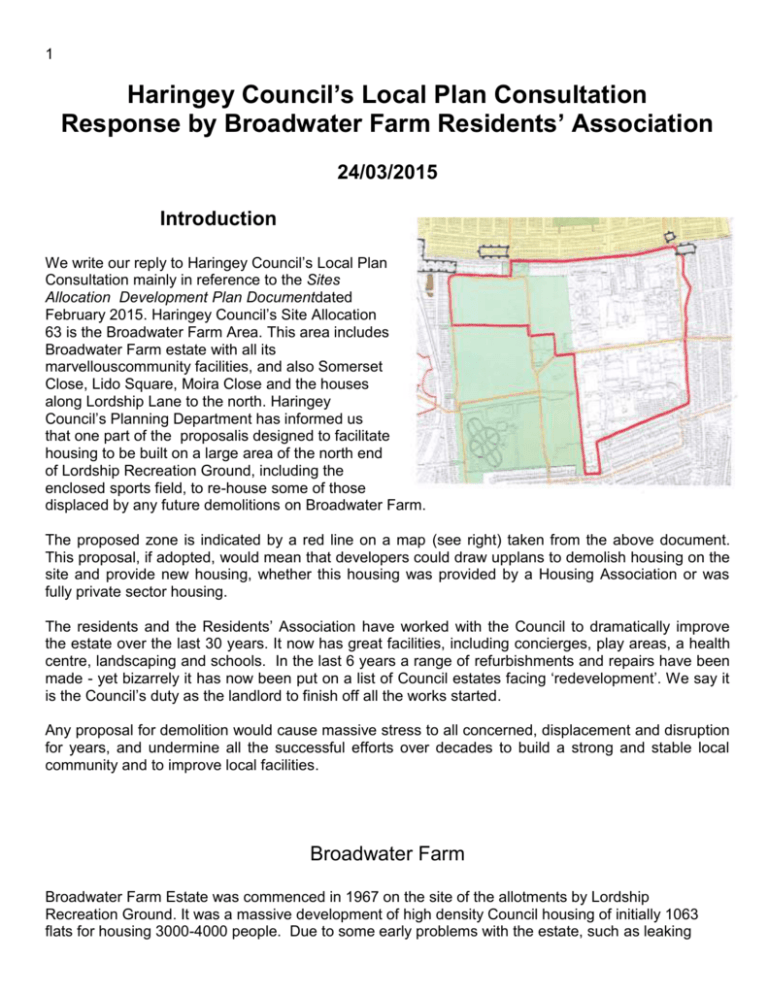`Redevelopment Zone` Proposal
advertisement

1 Haringey Council’s Local Plan Consultation Response by Broadwater Farm Residents’ Association 24/03/2015 Introduction We write our reply to Haringey Council’s Local Plan Consultation mainly in reference to the Sites Allocation Development Plan Documentdated February 2015. Haringey Council’s Site Allocation 63 is the Broadwater Farm Area. This area includes Broadwater Farm estate with all its marvellouscommunity facilities, and also Somerset Close, Lido Square, Moira Close and the houses along Lordship Lane to the north. Haringey Council’s Planning Department has informed us that one part of the proposalis designed to facilitate housing to be built on a large area of the north end of Lordship Recreation Ground, including the enclosed sports field, to re-house some of those displaced by any future demolitions on Broadwater Farm. The proposed zone is indicated by a red line on a map (see right) taken from the above document. This proposal, if adopted, would mean that developers could draw upplans to demolish housing on the site and provide new housing, whether this housing was provided by a Housing Association or was fully private sector housing. The residents and the Residents’ Association have worked with the Council to dramatically improve the estate over the last 30 years. It now has great facilities, including concierges, play areas, a health centre, landscaping and schools. In the last 6 years a range of refurbishments and repairs have been made - yet bizarrely it has now been put on a list of Council estates facing ‘redevelopment’. We say it is the Council’s duty as the landlord to finish off all the works started. Any proposal for demolition would cause massive stress to all concerned, displacement and disruption for years, and undermine all the successful efforts over decades to build a strong and stable local community and to improve local facilities. Broadwater Farm Broadwater Farm Estate was commenced in 1967 on the site of the allotments by Lordship Recreation Ground. It was a massive development of high density Council housing of initially 1063 flats for housing 3000-4000 people. Due to some early problems with the estate, such as leaking 2 roofs, residents banded together and convinced the Council to carry out works on the buildings. By 1981 a process of refurbishment had started, but progress was slow. Residents created a very active Youth Association and a Residents Association. From the mid-1980s the Council consulted the residents about a new program of needed works and residents identified the improvements they wanted with the Council agreeing to implement them and finding the funds to do so. The community-led regeneration of the estate attracted over £40m of resources and has been a huge success.All of the tenants’ recommended solutions were carried out by the Council. Improvements included concierges for all blocks, play areas, landscaping, workshops for rent, a health centre, a community centre, a new school campus, bus route through the estate, and more. It is now one of the most well-served Council housing estates in the UK and regularly attracts visitors from around the world who wish to see this great example of successful community-led regeneration. Broadwater Farm Residents’ Association The current Broadwater Farm Residents’ Association was established in 1987, originating from the Broadwater Farm Youth Association. It was established to look at the issues of lack of representation and deprivation on the estate as well as to raise community spirit. It has held regular meetings with councillors and council officials over the years to achieve these goals. The current committee was elected at an Annual General Meeting in July 2014. We hold committee meetings on a monthly basis. We continue to organise events for local residents. In 2014, for example, there was an Open Day regarding repairs, an Estate Day with various fun activities for children and other residents and a children’s Christmas Party. We organised these events in partnership with Homes for Haringey and other organisations such as the Church on the Farm. SA63: Proposal to ‘Improve Stock’ Broadwater Farm Residents’ Association certainly wants improvement of the existing housing on Broadwater Farm. We believe the principal way of securing this improvement is through Decent Homes work. This should include new front doors, kitchens and bathrooms for the existing blocks. (Tangmere in addition requires new roofs, windows and other works to the exterior of the block). It should also include work to ensure good insulation and other work to the existing blocks as necessary. We also believe that our blocks require redecoration: painting of communal areas and new, more attractive flooring. We are very concerned that the proposal in SA63 to ‘Improve Stock’ in fact bears no relation to these aspirations but could actually facilitate wholesale demolition and rebuilding. We find evidence of this in the proposed Alterations to Haringey’s Adopted Strategic Policies 2011-2026. Alteration 53 sets out an initial list of housing estates to be ‘regenerated’. Broadwater Farm is one of the estates set out here. The reason box for Alteration 53 states that the alteration: ‘Recognises the Council’s commitment to improving its existing housing stock and the limitations of 3 the Decent Homes Programme for asignificant number of Council-owned homes.’1 This implies that estates, such as Broadwater Farm, which are on this specific ‘regeneration’ list will not receive further decent homes work but will face a different sort of future. The type of ‘regeneration’ Broadwater Farm may well face seems to be set out under Alteration 64 of the same report that states under the heading ‘Haringey’s Housing Estate Regeneration’: ‘…re-provision of low quality existing council housing with an equal quantum (on a habitable rooms basis) of higher quality modern social housing is not a financially viable option. The building of higher density mixed tenure developments, which increase the quality andrange of the affordable housing options for local people islikely to be the only realistic options [sic], and even then, willrequire significant public subsidy may require flexibleapplication of normal planning policy expectations for affordable housing provision.’ 2 The clear implication here is that estates on the regeneration list may well be knocked down and replaced with high density mixed tenure developments with a relatively low percentage of social, rented housing. The possibility of the demolition of council housing on the Broadwater Farm site has been broached in meetings between members of the Broadwater Farm Residents Association Committee and Steve Kelly of the Planning Department on 18/02/2015 and 16/03/2015 and by members of our Association and Matthew Pattison of the Planning Department on 09/03/2015 at the West Green and Bruce Grove Area Forum. At both meetings Mr Kelly rather reluctantly agreed that demolition and rebuilding of blocks in addition to Tangmere (see below for issues related to Tangmere) could be a possibility on the site but stressed that his Department was not responsible for this decision and that no concrete plan for this had yet been drawn up. Mr Kelly stated in both meetings that the allocation of land on Lordship Recreation Ground was necessary for building new homes for decanted residents from Tangmere. Mr Pattison went further at the Area Forum on 09/03/2015 and said the land might be needed if blocks at Broadwater Farm need to be decanted, i.e. the land would house residents from more than one demolished block. It is obvious that the inclusion of Broadwater Farm on the Site Allocations plan does make demolitions of council blocks on Broadwater Farm a possibility and not only Tangmere, in the absence of any statement in the plan to the contrary. Broadwater Farm Residents’ Association does not agree that the potential demolition of the blocks we live in should be described as a way to ‘improve stock’. No report exists that indicates that the buildings on the Broadwater Farm are in any way structurally unsound. Stock should be improved by the type of decent homes work detailed above. In addition all the facilities and features serving and enhancing the estate should be treasured and protected. Further reasons for our opposition to demolitions will be detailed below. Haringey Council’s Unwillingness to Re-provide Genuinely Affordable Housing on Regeneration Estates As the quote from Alteration 64 above indicates Haringey Council has no intention to re-provide an equal quantity of social housing when it demolishes social housing as part of estate regenerations. 1 Alterations to Haringey’s Adopted Strategic Policies 2011-2026, dated February 2015, page 22. page 27. 2Ibid., 4 SA63 does indicate that there should be no loss of ‘affordable housing floor space’ in the development of Broadwater Farm. ‘Affordable housing’, however, is a broad term and is not the same thing as social housing with a permanent tenancy, that is let at a social housing rent similar to those currently charged for council housing. Alteration 64 indicates that most, if not all, of the new affordable housing that would be built on the Broadwater Farm site would be either shared ownership or ‘affordable’ rented housing that can be let at up to 80% of market rent.If we look at Appendix C of the Consultation on Haringey’s Draft Housing Strategy 2015-2020, neither option is likely to be affordable for Broadwater Farm residents. Let us take rents set at 65% of the average private sector rent for Haringey (65% is the blended average of rents for Affordable Homes in London and Haringey). We see that this figure is £812.50 per month3 . Appendix C to the report finds this just about affordable for a household on the median Haringey household income of £33,140 a month. The same report, however, indicates that the median household income for West Green ward is barely over £20,000 a month. 4 This would indicate that ‘affordable’ housing built on the Broadwater Farm site is likely to be unaffordable for local residents. The report is quite clear that shared ownership homes will not be affordable to the majority of Broadwater Farm residents. It indicates that new shared ownership homes in Tottenham require a minimum household income of £34,709 5. Given reductions in government grants for new social housing build, it is very unlikely that Haringey Council could demolish an estate the size of Broadwater Farm and re-provision anything but a small proportion of the homes at social rent. So-called ‘Affordable Rented’ housing and Shared Ownership are outside the income ranges of most Broadwater Farm residents and most Tottenham residents. Paragraph 3.2.2 of Haringey’s Local Plan: Strategic Policies 2013-2026 states that: ‘The Council will seek to ensure that everyone has the opportunity to live in a decent home at a price they can afford and in a community where they want to live.’ For the above reasons, we believe that the demolition of the Broadwater Farm and other council estates in Tottenham contravenes the Council’s own policies. We therefore state that the only way to maintain the current supply of truly affordable housing in Tottenham and on the Broadwater Farm site is not to carry out demolitions of council homes. The Negative Equalities Impact of Demolitions on Broadwater Farm In reference to the above section the following should be noted from the Equalities Impact report: ‘Incomes in east and central Haringey have reduced between 2010 and 2012/13 whereas they have risen in west Haringey over the same period. See Consultation on Haringey’s Draft Housing Strategy 2015-2020, Appendix C http://www.minutes.haringey.gov.uk/Published/C00000118/M00006978/AI00041306/$Cabinet170315AppxCHaringeyHou singStrategyEqIAFINAL.doc.pdf page 53-4. 4Ibid., page 58. 5Ibid., note 5, page 53. 3 5 Black households are represented more in the east of Haringey than they are in the west of the borough and conversely White households arerepresented more in the west of the borough, than in the east. Initial data on buyers of shared ownership homes show that Black and ethnic minority buyers are under-represented in new schemes whilst Whitebuyers are over-represented in comparison with their representation in the general population of Haringey… The above evidence indicates there is a possibility that over time Black residents in Haringey may not benefit from the plans to build more homes in theborough through promoting affordable home ownership in east Haringey. White households may benefit more easily.’ 6 We would also note council plans to house more homeless families outside London (see Haringey Council’s Corporate Plan, Medium Term Financial Strategy 2015/16 to 2017/18) 7. (This was a report made to the Cabinet as part of agenda papers on 16/12/2014.). Clearly demolishing social housing without appropriate replacement in areas like Broadwater Farm will lead to increasing numbers of Haringey’s homeless families being forced out of London. This pressure to move out of London, adds to the discriminatory nature of the proposal to demolish social housing. As Appendix C of the Consultation on Haringey’ Draft Housing Strategy 2015-2020 states: ‘Black households approach as homeless at a level which is more than twice their representation in Haringey’s population compared with White households who present in numbers which are around two thirds of their representation in Haringey’s general population. This indicates that Black households are particularly affected by homelessness in the borough.’ 8 Therefore reducing the amount of social housing will make black households disproportionately likely to be forced to leave the borough and indeed London. This is additional evidence of the discriminatory nature of the Council’s plan for Broadwater Farm and Tottenham as a whole. We are also concerned that the letters regarding this consultation have only gone out in Englishand that a member of the Residents’ Association committee was informed on 16/03/2015 by Haringey Council’s Planning Department that consultation responses in Turkish would not be considered. We believe this contravenes that duty of Haringey Council to consult all sections of the community equally about the Local Plan. We believe that the Local Planpolicy will discriminate against black households and the consultation on it was carried out in a way that excluded Turkish speakers. We believe that both of these factors breach the commitment in Haringey Council’s Equal Opportunities Policy of April 2012 to the fair provision of services. In addition the official summary in the DPD of what the S63 zone proposal would mean is inaccurate, vague, misleading and meaningless. This renders any meaningful ‘consultation’ impossible, or more likely biased in favour of the Council’s unilateralagenda for the area.. 6Ibid., page 12 Plan, Medium Term Financial Strategy 2015/16 to 2017/18at http://www.minutes.haringey.gov.uk/Published/C00000118/M00007188/$$ADocPackPublic.pdf page 205 8Consultation on Haringey’s Draft Housing Strategy 2015-2020, Appendix C, page 5. 7Corporate 6 We are concerned that a ‘regeneration’ of the Broadwater Farm that leads to the building of a large amount of Shared Ownership properties would disadvantage the black community and contravene Haringey Council’s commitment to equal opportunities as indicated by their own Equalities Assessment. We also believe that providing homes at 65% market rent would have a similar impact due to lower median incomes in the East of the borough as indicated on page 58 of the Equalities Assessment document. Where will Secure Housing Tenants be Re-housed? Thousands of council homes are potentially at risk of demolition in Haringey. Alteration 53 to the Strategic Policies lists Northumberland Park, Love Lane, Turner Avenue and other smaller sites on the list for estate regeneration. There is a proposal to build 2,000 extra homes on the Northumberland Park Site Allocation area, according to a recent council newsletter 9. Given the location and size of the ‘regeneration area’ this will clearly involve the demolition of many council homes in Northumberland Park. Residents across Haringey are being consulted about regeneration and therefore potential demolition at many other sites such as Tamar Way, Reynardson Court, Leabank View/Lemsford Close and some blocks on Imperial Wharf. We are concerned that with such a reduction in the supply of council housing, decanted residents from Broadwater Farm may end up with a very limited choice,if any, of where to move to. Leaseholders and Their Tenants Flats on Broadwater Farm tend to sell for a fairly low value of between £100,000 to £150,000 depending on size, as a quick survey of the Rightmove website indicates. Property values in the rest of Haringey and indeed London are much higher. Many leaseholders on Broadwater Farm will face having to move out of London entirely if their homes are demolished, even if they receive the current market value for their home. In addition, it must be noted that the private tenants of leaseholders may end up homeless if their homes are demolished and they do not fall into one of the Council’s ‘priority need’ categories, such as having dependent children or having a disability. The Issue of Tangmere in Relation to the Potential Demolition of Other Council Blocks on the Broadwater Farm Estate Tangmere has a different design to the other blocks. Tangmere residents are currently being consulted in a Homes for Haringey Steering Group where demolition has been openly discussed. The principal reasons given for the concerns about Tangmere’s future appear to be a fairly large number of leaks in the block and anti-social behaviour . At the last Steering Group meeting on 18/02/2015 the Repairs Department attended and stated they were doing extensive work on unblocking pipes, as pressure from water in blocked pipes on joints was deemed to be a major cause of leaks. It was also agreed to restore lighting to unlit parts of the car park due to resident complaints about car break-ins. The restoration of lighting has now been mainly done. Given we have been given no evidence of any actual structural problem at Tangmere, it must be suggested that the problems at Tangmere could 9http://www.haringey.gov.uk/sites/haringeygovuk/files/northumberland_park_newsletter_january_-_lores.pdf 7 probably be addressed through better management and maintenance and it does not seem likely that demolition is necessary. The meetings of the Steering Group have already brought about improvements in the block and it is rather ‘lazy thinking’ for Haringey Council to suggest when there are maintenance or anti-social behaviour problems in a block that demolition must be put on the agenda rather than helping residents explore other alternatives. One point we wish to make, however, is that any problems in Tangmere that might exist should not be used as a ‘Trojan Horse’ for facilitating demolitions of any other blocks on Broadwater Farm. The current site allocation would enable developers to come forward with plans for demolitions of all blocks on Broadwater Farm, not just Tangmere. If it really is the case, that only Tangmere is being considered for demolition, which seems unlikely for reasons laid out above, then it must be asked why the Site Allocations plan does not indicate that all the other blocks will definitely not be demolished. This point does not in any way indicate that Broadwater Farm Residents’ Association supports the demolition of Tangmere. We do not, and insist the necessary repairs be completed. Conclusion Broadwater Farm provides decent quality housing for thousands of people. It is a strong, vibrant community. Huge amounts have been spent on providing concierge suites, new roofs and windows, providing a Community Centre and many other facilities. All residentswant to look to the future on our estate, rather than having our lives needlessly disrupted by demolitions and decants. On 09/03/2015 at the Area Forum, Matthew Pattison of the Planning Department indicated that Haringey Council has no evidence of any structural problems with the blocks at Broadwater Farm. The Planning Department is also clear that any redevelopment of the Broadwater Farm would not lead to a net increase in the number of houses on the site and would therefore have no impact on the Mayor of London’s target for 1,502 new homes a year for Haringey. These two facts must clearly beg the question, what is the point of demolition and rebuilding? One claimed point of the Broadwater Farm Site Allocations is the improvement of access to Broadwater Farm. We would accept this only if the Site Allocation plan is changed to clearly state that these plans would not involve home demolitions or loss of green space. Given the housing shortage in Haringey schemes like this should not be carried out at the expense of home demolition. Similarly, we will only accept the inclusion of the Broadwater Farm on the Site Allocations list if it is stated clearly on the Site Allocations document that homes will be improved but none will be demolished. Demolition of housing on Broadwater Farm would lead to a huge loss of socially rented, genuinely affordable housing. Current options for ‘Affordable Rent’ housing or Shared Ownership housing on the site would not be genuinely affordable for the majority of households in Tottenham. Demolition and rebuilding would contravene Haringey’s commitment to equal opportunities. Finally, we wish to state that we are horrified by the plans to build housing on Lordship Recreation Ground. This area is where young people from our estate play sports. It is a 8 beautiful area that has had a large amount of money spent on it. Building on Lordship Recreation Groundwould be an act of vandalism and we cannot believe that the Council could be seriously considering such a plan alongside the consideration of demolishing blocks on Broadwater Farm.




